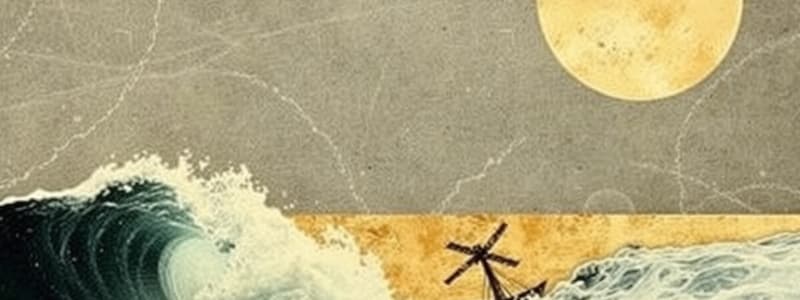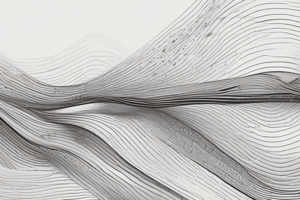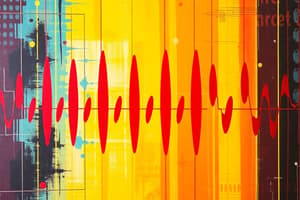Podcast
Questions and Answers
What is wave height?
What is wave height?
Vertical distance from crest to trough.
Define wave period.
Define wave period.
Time required for 2 successive crests or troughs to pass a given point.
What is the formula for frequency?
What is the formula for frequency?
- Frequency = 1/T^2
- Frequency = T^2
- Frequency = 1/T (correct)
- Frequency = T/1
What are the principal factors that control the variety and size of wind-generated waves?
What are the principal factors that control the variety and size of wind-generated waves?
What is significant wave height?
What is significant wave height?
What is the relationship between wave speed and wave energy?
What is the relationship between wave speed and wave energy?
What is a progressive wave?
What is a progressive wave?
Define celerity.
Define celerity.
What type of wave travels through water deeper than its wave base?
What type of wave travels through water deeper than its wave base?
Match the wave types with their descriptions:
Match the wave types with their descriptions:
Flashcards are hidden until you start studying
Study Notes
Wave Parameters
- Wave height is the vertical distance from the crest to the trough.
- Wave period is the time taken for two successive crests or troughs to pass a point.
- Amplitude is the vertical distance from the crest to the mean level, equating to half the height of the wave.
- Frequency is the number of wavelengths passing a fixed point over a time period and is calculated as Frequency = 1/T.
- Steepness is the ratio of wave height (H) to wavelength (L), expressed as Steepness = H/L.
Wave Types & Formation
- Four main factors control the size and variety of wind-generated waves:
- Wind velocity
- Wind duration
- Fetch (area of water over which the wind blows)
- Original sea state
- Waves grow in size until reaching a maximum, influenced by wind speed and fetch, termed a fully developed sea.
Significant Wave Height
- Significant wave height is the average of the highest one-third of waves in a specific area and is greater than the average wave height.
- The formula for significant wave height is Hs≈Hm0=4[E/(gρ)]^1/2, where Hm0 represents the spectral significant wave height.
Mean and Peak Wave Periods
- Mean wave period (tm) is the average of all wave periods in a time series for a sea state.
- Peak wave period (tp) is the period with the highest energy, analyzed through wave energy distribution based on frequency.
Mean Wave Direction
- Mean wave direction Dir(m) is the average of all individual wave directions in a time series for a sea state.
Wave Motions
- Waves are categorized into two types based on motion:
- Progressive Waves: Wind-generated waves that move across the sea surface; water molecules move in the direction of the wave at the crest and opposite at the trough.
- Standing Waves: These waves do not move horizontally and oscillate around a fixed point (node).
Characteristics of Progressive Waves
- As waves pass, wave form and energy move forward, while water molecules engage in orbital motion, with the diameter of orbits enlarging with wave size and reducing with shallow depth.
- Wave base is the depth affecting wave movement; if the depth is greater than wave base, orbits are circular with no interaction with the bottom; if shallower, orbits become elliptical.
Wave Classification by Depth
- Deep-water Waves: Travel through water deeper than half their wavelength.
- Intermediate-water Waves: Travel through depths between one-half and one-twentieth of their wavelength.
- Shallow-water Waves: Travel in depths less than one-twentieth of their wavelength.
Celerity (Wave Speed)
- Celerity refers to the speed of the wave form rather than the water itself.
- The speed formula applies to individual waves; wave groups and energy travel slower than single waves.
Chaotic Waves and Wave Interference
- Chaotic seas consist of multiple waves of varying lengths, heights, and periods, merging and separating as they move in different directions.
- Wave interference results in complex wave patterns due to overlapping characteristics of numerous waves.
Studying That Suits You
Use AI to generate personalized quizzes and flashcards to suit your learning preferences.




